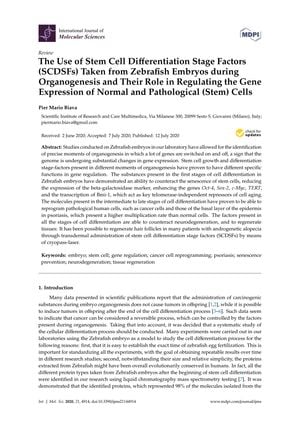The Use of Stem Cell Differentiation Stage Factors Taken from Zebrafish Embryos During Organogenesis and Their Role in Regulating Gene Expression of Normal and Pathological Cells
July 2020
in “
International Journal of Molecular Sciences
”
Stem Cell Differentiation Stage Factors SCDSFs zebrafish embryos gene regulation stem cell aging reprogram pathological cells neurodegeneration tissue regeneration hair follicles androgenetic alopecia cryopass-laser psoriasis stem cell multipotency stem cell factors hair follicle regeneration hair loss skin disease

TLDR SCDSFs from zebrafish embryos are beneficial for treating cancer, regenerating tissues, and improving conditions like psoriasis and alopecia.
The document reviewed the potential of Stem Cell Differentiation Stage Factors (SCDSFs) from zebrafish embryos in gene regulation for normal and pathological cells. It highlighted that SCDSFs could prevent stem cell aging, reprogram pathological cells to normal phenotypes, counteract neurodegeneration, and regenerate tissues, including hair follicles in androgenetic alopecia patients using cryopass-laser. Clinical trials showed promising results: a trial with 179 hepatocellular carcinoma (HCC) patients resulted in a 19.8% regression rate and a 16% stabilization rate, with over 60% survival after 40 months for responders. Another trial with advanced-stage colon cancer patients found increased survival and preserved performance status when treated with Regorafenib plus SCDSFs compared to Regorafenib alone. SCDSFs also improved psoriasis outcomes and promoted stem cell multipotency. A trial with 20 men with androgenetic alopecia treated with SCDSFs and cryopass-laser showed significant hair follicle regeneration and maintained results after six months. The document concluded that SCDSFs are beneficial for cancer treatment, tissue regeneration, and diseases like psoriasis and alopecia.



